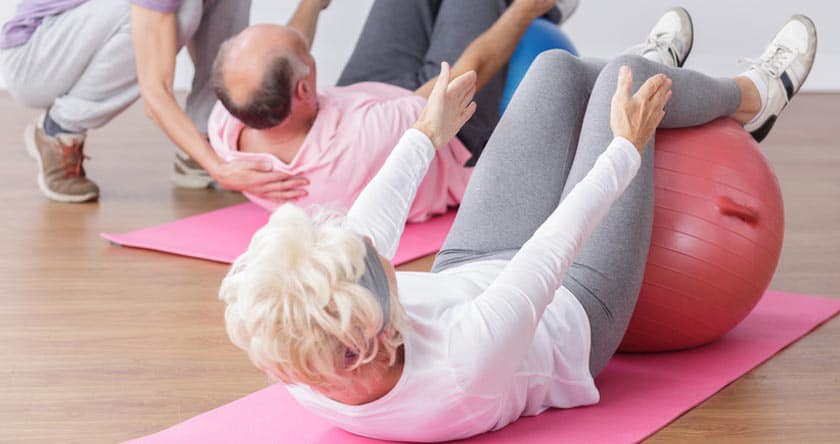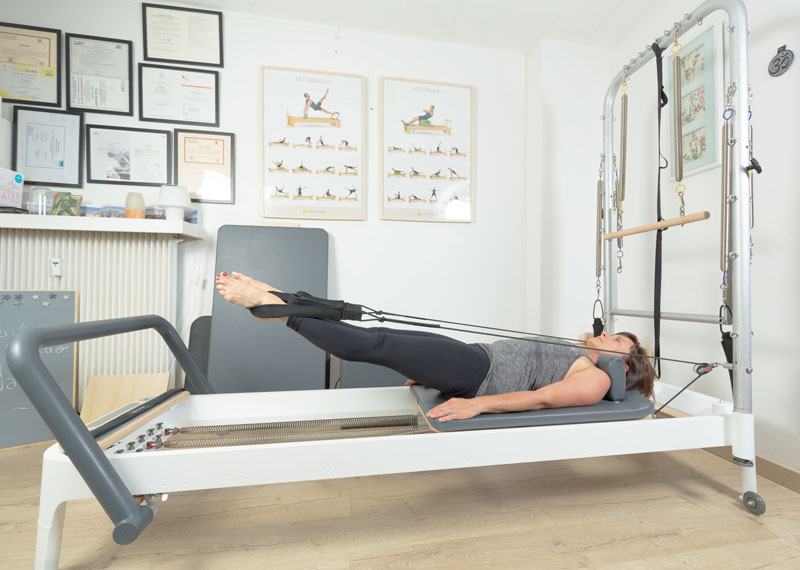The benefits of Pilates
Pilates classes : an effective method!
Pilates is a complete training technique, both from a health and aesthetic point of view. Pilates helps to remedy back pain, muscular injury or to refine the silhouette. A range of exercises will help you to learn or relearn how to find an optimal posture through self-expansion (decompression of the vertebrae), neutral pelvic positioning and core strengthening. Pilates helps to relieve minor traumas due to bad habits induced by sedentary lifestyles, car travel, frequent use of the computer or mobile phone, carrying heavy or light loads, and asymmetry in daily movements.
Many people think that Pilates is gentle gym when in fact it is a physical activity requiring sustained effort. It is a homogeneous and integral physical training of muscular reinforcement and postural rehabilitation.
Benefits of doing Pilates
• Trains the body as a whole
• Increases flexibility, muscle strength and strengthens joints.
• Promotes good posture by correcting the alignment of the body (especially the spine)
• Helps to achieve good posture and a toned body
• Improves flexibility, coordination and balance
• Helps to manage stress
• Strengthens the abdominal muscles for a flat stomach
• Strengthens all muscle chains
• Reduces or eliminates back pain, migraines
• Protects against recurring injuries
• Improves concentration
• Helps to prevent sports injuries
• Helps to manage the menopausal period
• Improves and stimulates the respiratory and circulatory systems
• lengthens and strengthens” par “lengthens and strengthens the body, thanks to singular work which strengthens the muscles by lengthening and refining them
• Facilitates the correction of certain musculoskeletal conditions
• Facilitates the elimination of stress and stress-related disorders through individualized attention and focus.
Pilates requires discipline and concentration.
The participant must be prepared to make strenuous efforts, both physical and mental.
Pilates to fight against osteoporosis

Osteoporosis is characterised by a loss of bone strength leading the person to be prone to fractures. In most cases, the bones become brittle due to a lack of calcium, phosphorus and other minerals. Osteoporosis makes the bones more porous and more likely to fracture in, what would normally be, a trivial fall and therefore would normally have no consequences. It is not a disease, but a natural process that is generally related to aging. In the majority of cases, osteoporosis occurs in people aged 65 and over, but sometimes it can occur earlier.
Studies show that exercise is good for bones throughout life. At least 3 hours of activity per week is recommended. Pilates sessions are equally concerned with the loading of the various machines. The exercises not only strengthen the body’s structure (muscles and bones), but also aim to improve balance, thus helping to prevent the risk of falling. Therefore, exercises that require rotation of the spine or bending are not allowed. All exercises can be modified and therefore adapted according to the extent of osteoporosis.
Pilates for osteoporosis is safe for people living with the disease. Regular physical training strengthens muscles and bones to combat the risk of osteoporosis-related accidents.
Work and exercises to relieve our feet
Keeping our feet healthy is important for our whole body. They are the very foundation of the human skeleton and yet we don’t pay enough attention to them, or barely take care of them, and yet our feet carry us through life. Their structure is similar to the foundation of a building, which means that we need to preserve it so that it remains stable and solid. This requires regular exercise to keep the muscles, tendons and ligaments healthy so that they can better support the bone structure of the foot.
Pilates is a training method that maintains the mobility of the feet by increasing stability and strengthening the ankles, as well as making them more flexible. It also allows for a better alignment of the foot from the propulsion and the correction of any weaknesses. During our Pilates sessions, the work consists of strengthening the feet and stretching them through the practice of various exercises, either with specific machines or with small equipment, such as handkerchiefs, pencils or marbles, etc. During the exercises, perfect alignment should be maintained. The core of the body (the deep muscles of the abdomen) are also used to create a space between the abdomen and the spine, allowing the rest of the body to move freely.
Indirect benefits of footwork include stimulation of the internal organs, improved blood circulation and better elimination of toxins.

Pilates to relieve sciatica

The sciatic nerve is the longest nerve in the human body, and the one with the largest diameter. It originates from several nerve branches in the spine, in particular from the roots of the last two lumbar vertebrae (L4 and L5) and the first three sacral nerves.
It then continues to the buttock, to the posterior aspect of the leg and is divided at the posterior part of the knee. In this way it provides motor control and sensitivity to the posterior thigh. The sciatic nerve is involved in sciatica, which causes pain that can extend from the buttocks, thighs, legs, feet and even to the toes.
There are other symptoms such as:
• fatigue, numbness or tingling in the leg or foot
• inability to bend the foot enough to walk on heels
• a feeling of heat or electricity running through the leg
• reduced reflexes in the Achilles heel or knee.
Our Pilates sessions stretch and relax the muscles of the leg and lower back. By engaging the deep muscles, and seeking to self-expand the spine, pressure on the vertebrae and discs is reduced. Subsequently, various exercises are suggested to work on the mobility of the hips and the rest of the body. Regular practice of specific Pilates exercises and stretching with proper breathing will reduce pain and prevent further inflammation.
The Pilates method allows you to maintain a better posture in everyday life and greatly relieves sciatica.
Muscle cramps
Muscle cramps are, along with muscle soreness, the most common muscle pain in sport.
Cramps occur during or after exercise. They are the true watchdogs of muscular fatigue and appear during muscle contraction. Under nervous impulse, the muscle fibres retract and cause the muscle to shrink by 30 to 50%. Cramps occur most often during prolonged effort because the energy reserves are exhausted and the muscle no longer relaxes. They generally affect the lower limbs: thighs, calves, feet, toes, etc.
Certain factors aggravate the onset of cramps: age, the side effects of certain drugs or circulatory problems (what to do about it), the cold (cover up well), dehydration (drink plenty, but not just anything!), coffee, tea or alcohol abuse (see previous comment), badly fitting shoes (change them!), an infectious condition (the flu is fatal) as well as a state of stress. (Pilates classes are ideal for relaxing ).
3 AREAS OF PREVENTION:
Nutrition
You can make a difference by eating green and dried vegetables, wholegrain cereals, almonds, dark chocolate or honey to top up on magnesium levels and essential trace elements to avoid cramps. Dried apricots and bananas provide potassium which reduces motor disorders.
Hydration
It is necessary to drink enough before exercise as well as during the session. Drinking energy drinks rich in mineral salts or water rich in minerals and bicarbonates regularly after exercise helps to limit the occurrence of cramps.
Equipment
Recovery socks or compression sleeves improve blood circulation, prevent cramps and allow you to regain good venous circulation more quickly (you won’t see them under training leggings).
Reaction: action!
If the cramp still occurs, be guided by your instructor to stretch the sore muscle which will help relax it. Also, drinking a glass of sweetened water or putting ice on the muscle contracture will relieve the pain, as will immediately applying herbal roll-ons.
The benefits of Pilates during menopause
Menopause (The Change of Life) can be a challenging and anxious time in a woman’s life but also an interesting one. It is a time of physical, emotional and even spiritual change.
The Pilates training technique can help women through this complex transition in their lives by providing a specific programme to help them cope with these changes and the symptoms associated with them.
Our Pilates classes in Marseille help to influence posture, movement and the elimination of bad postural habits. Through our Pilates exercises, muscles lengthen and gain tone, muscle strength increases, abdominal and lumbar muscles are strengthened and blood circulation improves..
Take advantage of a great solution to build muscle mass and flexibility during menopause.
Our Pilates sessions include strengthening training (for bone health), cardiovascular work (for hormonal balance and to combat weight gain) and balance exercises. But above all the sessions include, stretching, relaxation and breathing exercises to reduce stress, facilitate lymphatic drainage and promote relaxation.
Pilates helps to tone and stretch deep muscles, loosen joints, and maintain the spine.
Pilates is therefore a great and comprehensive tool for achieving these goals, and for keeping women active, toned and healthy.
Pilates and hypercifosis or hyperlordosis scoliosis

The Pilates exercises work on the strength and flexibility of the spine to correct bad postural habits. The practice of Pilates allows you to be more in tune with your body, to understand it, to change the way you hold and position yourself in your daily life: walking, carrying bags, playing a musical instrument or practicing an asymmetrical sport.
There are several basic strategies to achieve this. These include:
• Lengthening the midline of the body, which will reduce the risk of developing kyphosis or lordosis associated with scoliosis.
• Visually developing symmetry around the centre line, (spine) and better locating the body parts with the manual guidance of your Pilates instructor.
• Use your body’s sensitivity to develop symmetry along the centre line with propioception, and thus recognise the difference between the two sides during an exercise or movement. If an exercise shows one side to be weaker than the other, then the corrective effort will be on that side. Similarly, if a stretch shows more stiffness on one side, then the flexibility exercises will focus on strengthening the weakened side.
• Rotational breathing and back breathing. This breathing is taught through the concave (non-bibbed) side of the scoliosis.
• Kyphosis is an exaggeration of the convexity of the dorsal region giving the back an overly rounded position. The cervical and lumbar parts of the spine have an exaggerated arch to counterbalance the convexity of the back due to kyphosis.
Our Pilates classes by appointment only to enable us to work in very small groups and therefore to reserve a place for you in the room.
Each session lasts 55 minutes and we pay particular attention to each of you with all the relevant and necessary alignment corrections.
Comfortable, but not too loose clothing is recommended so that you can observe how your body moves and places itself in the space around you.
We recommend to all those who wish to receive more attention and corrections, to those who are injured, or who wish to work at a different speed and more appropriate to their own abilities, to take private lessons with or without apparatus Pilates, according to their needs.
“In and up and forward.”
Joseph Pilates

Studio Nai'A
20, rue César Aleman
13007 Marseille
Tel: +33 7 83 77 68 43
Follow us:
© Studio Nai’A | Design by graphika.fr | Legal Notice






